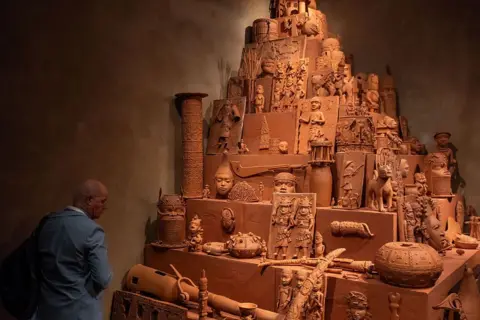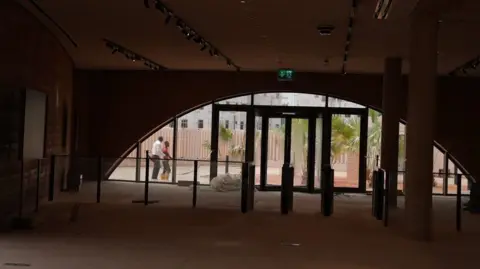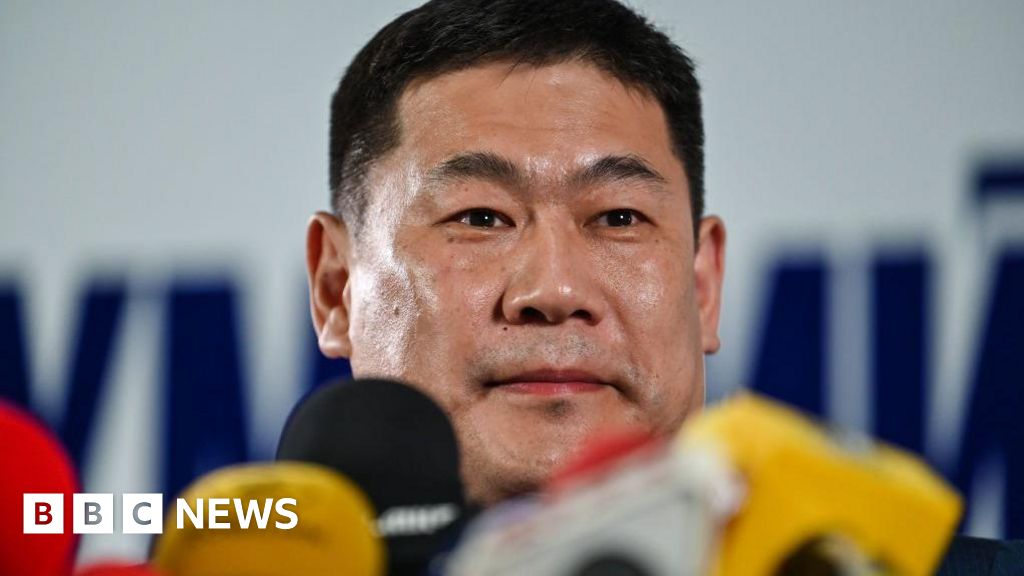ARTICLE AD BOX
Todah OpeyemiBBC Africa, Benin City

 AFP/Getty Images
AFP/Getty Images
Guests and dignitaries looked on as protesters stormed the Museum of West African Art in Benin City on Sunday
Nigeria's stunning new Museum of West African Art (Mowaa) has found itself in the crosshairs of local power politics on the week it was supposed to - but failed - to open its doors to the public for the first time.
The six-hectare (15-acre) campus sits in the heart of Benin City, capital of the southern state of Edo - and includes an archaeological dig and buildings designed by high-profile British-Ghanaian architect Sir David Adjaye, best known for the National Museum of African American History and Culture that opened in Washington in 2016.
It has been five years in the making - and is envisioned to celebrate both the past and the present of creativity in the region famous for the Benin Bronzes, artworks looted from the city's royal palace by British soldiers in the 19th Century.
It is impressive - and ahead of the planned opening, Mowaa was buzzing with staff determined to prove it is a place that can rival established museums and galleries in the West.
Inside conservators carefully unwrapped artworks from protective packaging, inspecting each piece and taking meticulous records before positioning them on walls and plinths.
Technicians fine-tuned climate control systems. In the materials science laboratory, officers calibrated equipment meant to preserve centuries-old artefacts.
The project has been the brainchild of businessman Phillip Ihenacho - now Mowaa's executive director.
"I want us to have a significant economic impact on communities around here," he told the BBC, adding that he hoped to make Benin City "a cultural destination".
Mowaa, a non-profit Nigerian institution, sees itself creating more than 30,000 direct and indirect jobs and contributing more than $80m (£60m) annually to the regional creative economy through partnerships and programming.
It has taken $25m (£19m) to get here - money raised from various donors, including the French and German governments, the British Museum and the Edo state government.
But now the local government has pulled the rug from under it - revoking the use of the land on which the museum was built.
An Edo state spokesperson told the BBC this was because in the original paperwork it had called itself Edo Museum of West African Art - and it had since dropped "Edo" from its name.
This announcement followed protests on Sunday, when people stormed the campus demanding it be called the Benin Royal Museum.
A rowdy group insulted foreign guests at the museum ahead of the opening - forcing them to be hurried away under police escort.
President Bola Tinubu has even stepped in to try and resolve the tensions, setting up a high-level committee to do some damage control.
But how has this become so politicised - and such a PR disaster?
Much of it comes down to internecine rivalries at a local state level, as it was Edo's previous governor Godwin Obaseki - whose term in office ended last year - who was a major backer of the museum.
And it seems the administration of the new governor, a close ally of the local traditional ruler, known as the Oba, may want more of a stake in the project. The protesters on Sunday, for example, were demanding that the museum be placed under the control of Oba Ewuare II.
This brings into focus the contentious issue of the Benin Bronzes, one of Africa's most celebrated cultural treasures.
Because even if the museum does eventually open, these bronzes will be conspicuously absent.
They are brass, ivory and wooden sculptures that once adorned the royal palace of the Benin Kingdom before British soldiers looted them in 1897 during a punitive expedition.
Today, thousands remain scattered across museums in Europe and North America -- including the British Museum, Berlin's Humboldt Forum and the Metropolitan Museum of Art.
Their return has become one of the most contested debates in the global art world. About 150 have now made their way home - and more are due to follow.
When plans for the museum in Benin City were first announced in 2019, the movers and shakers on Nigeria's art scene hoped it would become their natural home - a state-of-the-art complex to show them off to the world.
But the waters were muddied two years ago after the federal government announced that the Oba would be the rightful owner and custodian of any returned bronzes - and the palace pushed for a museum under the royal family's direct control, against the wishes of Obaseki, the former governor.

 AFP/Getty Images
AFP/Getty Images
The Oba of Benin at a ceremony in 2022 receiving one of the looted Benin Bronzes
This left Mowaa in a delicate position: asserting a clear stance on restitution while remaining diplomatic on custodianship - and emphasising its broader vision, which led to it dropping "Edo" from its name.
"One of the frustrations I've always had is that from the beginning we have said we will be about the modern and contemporary," said Mr Ihenacho.
"But because of the Western story about the return of the Benin Bronzes, everyone kept referring to us as the museum where they will go. The problem with that is we are not the owners, nor do we have any legal title to the bronzes."
His goal is to build a haven for contemporary African creativity, including film, photography, music, dance and fashion - not just visual art.
"Yes, we want to focus on the historical, but the purpose is to inspire the contemporary," he said.
"What we have become is a museum that is really about creating an ecosystem to support creatives in West Africa."
From a young Nigerian artist who relocated from the US to work as a conservator, to a recent graduate undergoing his one-year mandatory national youth service programme, to a Ghanaian PhD candidate conducting research, Mowaa has already become a hub of regional collaboration.
Eweka Success, a 23-year-old sculpture graduate from the University of Benin who has had a tour of Mowaa, welcomed this opportunity.
He noted that while many residents of the city "don't care" about the restitution conversation, the museum still offered something valuable.
"Many of us have never seen the originals, but there we can study their design, technique and history more closely," he told the BBC.
Cultural specialist Oluwatoyin Sogbesan agrees that the conversation has grown increasingly elitist.
"The everyday person is concerned about making a living, going to work, and feeding their family. Many don't even know about the bronzes," she told the BBC.
For her, restitution must move beyond just the return of artefacts to also restore memory and language.
"We need to decolonise the term 'Benin Bronzes' itself," she explained.
"Call them by their original Edo name – 'Emwin Arre' [meaning 'Cultural Things'] - what the people who made them would have called them."
This is something that chimes with the museum's inaugural exhibition - Homecoming - should it open to the public.

 AFP/Getty Images
AFP/Getty Images
Yinka Shonibare's installation features more than 150 clay replicas of the Benin Bronzes
It features works by acclaimed artists such as Yinka Shonibare, Toyin Ojih Odutola, Precious Okoyomon, and Tunji Adeniyi-Jones - many of whom live in the diaspora and have rarely exhibited in Nigeria.
Shonibare's Monument to the Restitution of the Mind and Soul has pride of place - a pyramid-shaped unit featuring more than 150 clay replicas of the Benin Bronzes.
"Creating a monument like this is acknowledging the trauma caused by the looting of those spiritual artefacts," he told the BBC. "It's a deeply emotional engagement with the trauma of the invasion."
He chose clay deliberately, as a metaphor for connection with the land of Benin itself.
"In the modern world, we seem to have become increasingly distanced from nature, whereas our ancestors had a deep connection and respect for it."
The pyramid evokes Africa's ancient wonders while the replicas speak to absence and memory.
"The work is conceptual - about the meaning of absence, the spiritual meaning of the bronzes," Shonibare explained. "In a way, the work is cathartic. It is almost mourning."


Staff at the museum hope the government will resolve the dispute that has marred the excitement there was last week over the opening
Also commanding attention is Ndidi Dike's 2016 mixed-media work National Grid, which reflects on power, both electrical and political.
Nigerians experience power outages so frequently they have become an accepted part of daily life - a metaphor Dike uses to question the nation's broader failures in governance and infrastructure.
It is something likely to resonate all too well for those working at Mowaa this week.
Though they may take heart from the words of the culture minister, who is chairing the presidential committee that wants to resolve the dispute.
"Cultural institutions are pillars of our national identity and must be protected through collaborative approaches that respect both traditional custodianship and modern institutional structures," Hannatu Musawa said.
There are fears the row may damage ongoing efforts to reclaim Africa's stolen art, with Western museums feeling justified about their concerns over the conservation of returned works.
But many working within the walls of Mowaa remain determined to show that their creativity can redefine what a modern African museum can be - with or without historic artefacts.
More from the BBC on Nigeria's Benin Bronzes:

 Getty Images/BBC
Getty Images/BBC

 3 hours ago
12
3 hours ago
12








 English (US) ·
English (US) ·